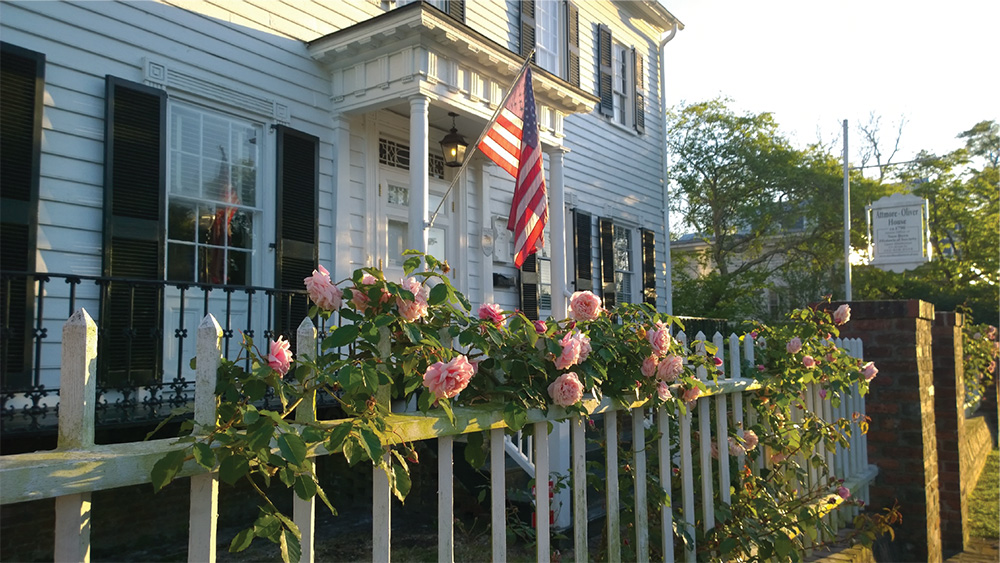
The Battle of New Bern
Visit the New Bern Historical Society's Civil War Battlefield Park to walk the hallowed ground on which soldiers lost their lives during the Battle of New Bern.
On March 13th 1862, 11,000 Union troops led by General Ambrose Burnside, along with 13 heavily-armed gunboats led by Commodore Stephen Rowan, landed at Slocum's Creek, now part of the Cherry Point Marine Corps Air Station. Their objective was capture of the town of New Bern because of its strategic position and the fact that the Atlantic and North Carolina railroad was also located here. Union strategists hoped to use New Bern as a stepping off point to cutting off the main Confederate north-south railroad supply line at Goldsboro.
The weather was cold and rainy as Burnside advanced his three brigades: BG John G. Foster on the right along Old Beaufort Road, and BG Jesse L. Reno on the left via the railroad, parallel to Old Beaufort Road, but farther inland. BG Parke's brigade was situated in reserve behind Foster. Commodore Rowan's gunboats would shell the shoreline just ahead of the Union advance.
Awaiting the Union forces were about 4,500 inexperienced and ill-equipped Confederate troops commanded by General Laurence O'Bryan Branch, a politician with virtually no military experience. Branch positioned his infantry regiments, one cavalry regiment, local militia and three gun batteries to defend a line extending from Fort Thompson on the Neuse River and running approximately one mile west to the Weatherby Road at the eastern edge of Brice's Creek.
Extending Branch's right wing to the railroad tracks was the 26th North Carolina Regiment commanded by Colonel Zebulon Vance, later governor of North Carolina. Redans were built along the confederate line of defense. Artillery and two companies of cavalry under Col Vance strengthened the right line with three infantry companies led by Lt Col Henry King Burgwyn, the "Boy Colonel," for he was not yet 21 years of age. However, he was an able leader, having graduated from VMI.
Lt Col Burgwyn's companies manned a series of redans situated on several promontories high above Bullen's Branch that had been dammed to create a depth of about four feet of cold water. An area south of the redans was cleared of trees extending out some 300 yards for a field of fire. The felled trees were fashioned into an abatis to further slow the attackers.
The battle began at 0730 on March 14th, and raged for nearly six hours. The main Union attack was in the vicinity of Fort Thompson. Despite support from Commodore Rowan's gunboats, this attack stalled. However, a regiment of General Parke's brigade flanked the position of a militia battalion in the vicinity of Wood's brickyard adjoining the railroad. Parke's infantry drove these poorly armed, fresh militiamen from their position leaving the right flank of the 35th North Carolina Regiment exposed. The Confederate line was broken between the 26th and the 35th regiments, and the Union forces pushed through forcing the retreat of the Confederate troops.
The Battle of New Bern was the baptism of fire for the 26th North Carolina. Later, in July 1863, the 26th lost 588 of 800 men at the battle of Gettysburg - sustaining the largest numerical losses of any unit, North or South, during the entire course of the war.
Estimated casualties for the battle: 1080 total. The fierce battle in the swamps and along the railroad five miles south of New Bern on March 14, 1862, proved to be a major victory for the Union and led to the ensuing occupation of New Bern for the remainder of the Civil War. Although Union forces never seized and held the rail line at Goldsboro, their presence in New Bern required the Confederacy to divert troops to the railroad's defense that might have been used in the critical battles in Virginia. For General Ambrose Burnside the New Bern victory was a factor in his subsequently being given command of the Army of the Potomac and leadership in the Union disaster at Fredericksburg.
Visit the New Bern Civil War Battlefield Park to walk the hallowed ground on which soldiers lost their lives during the Battle of New Bern. Click here for more information.
Purchase "The Battle of New Bern and Related Sites in Craven County, NC, 1861-1865." Click over to the bookstore to purchase.


